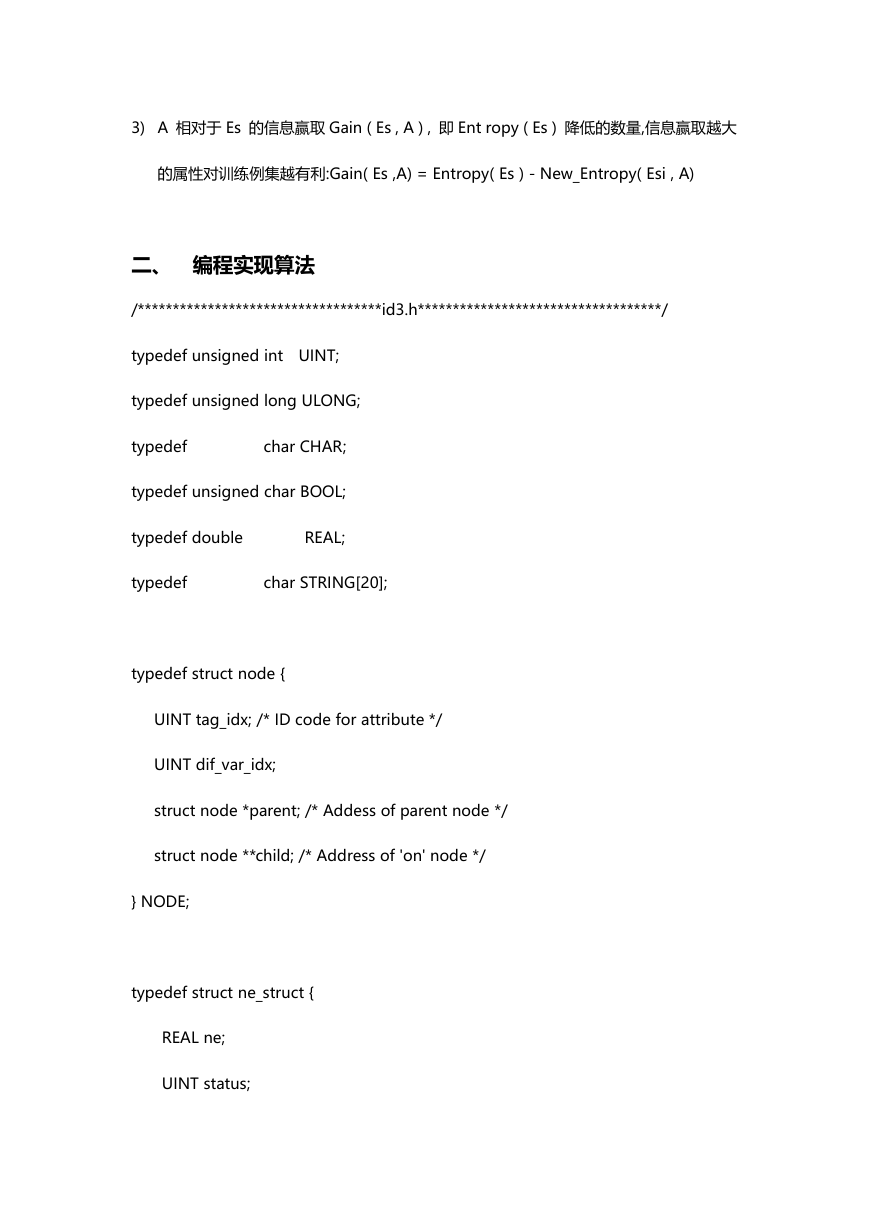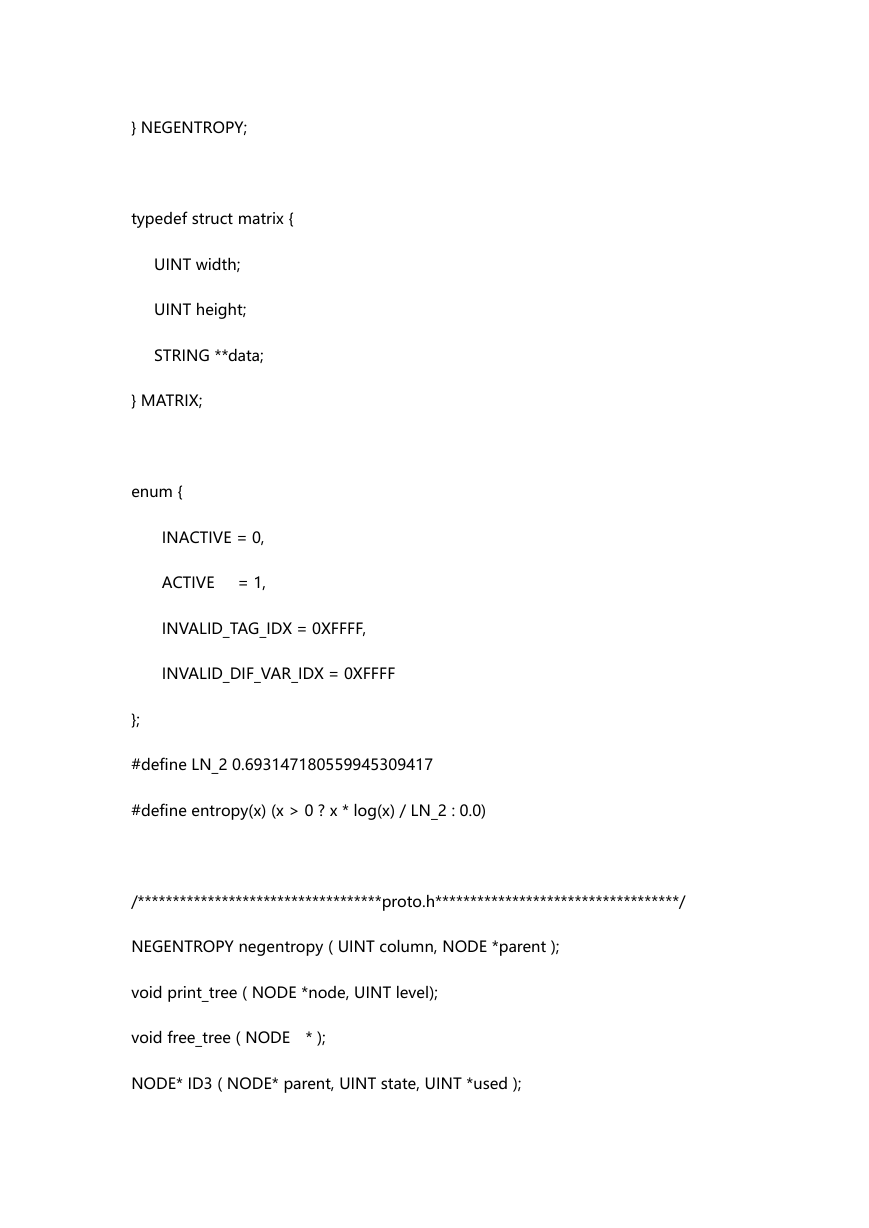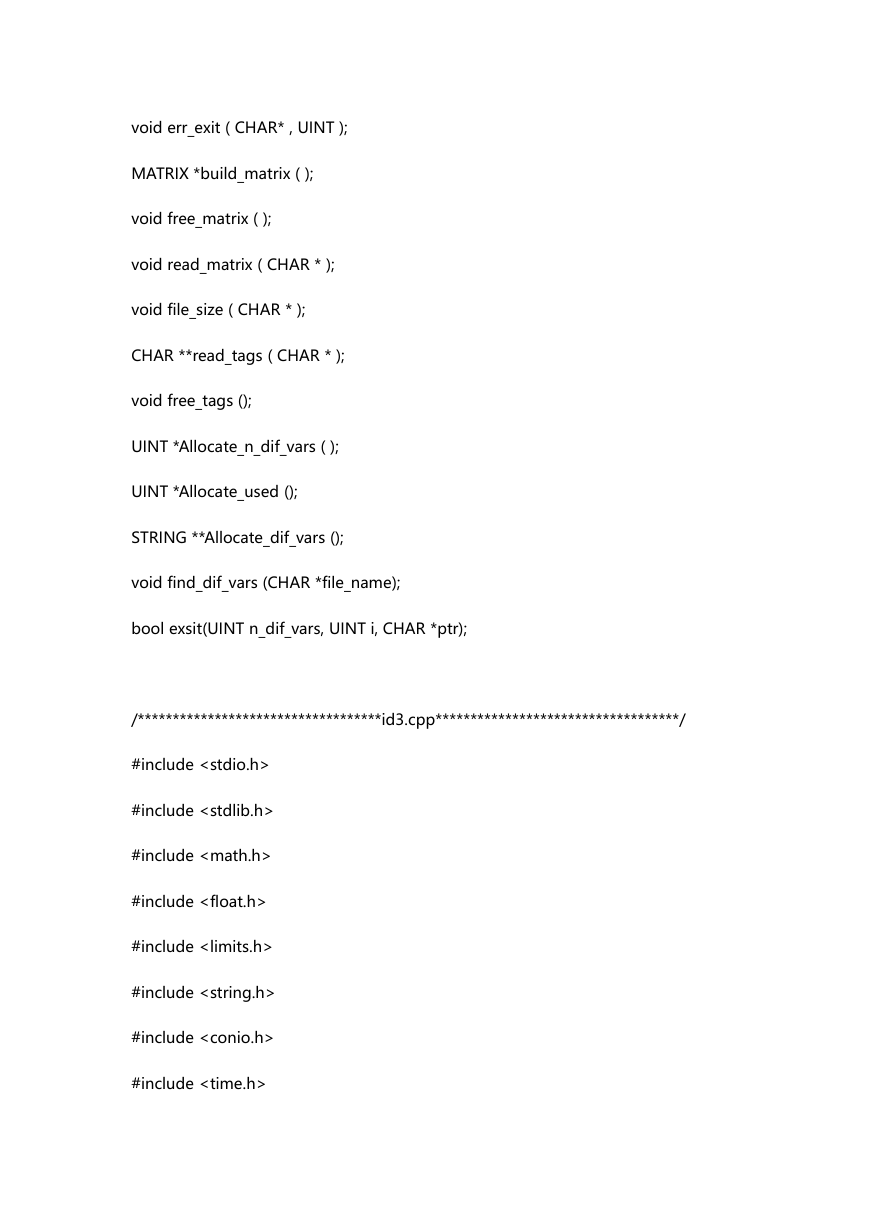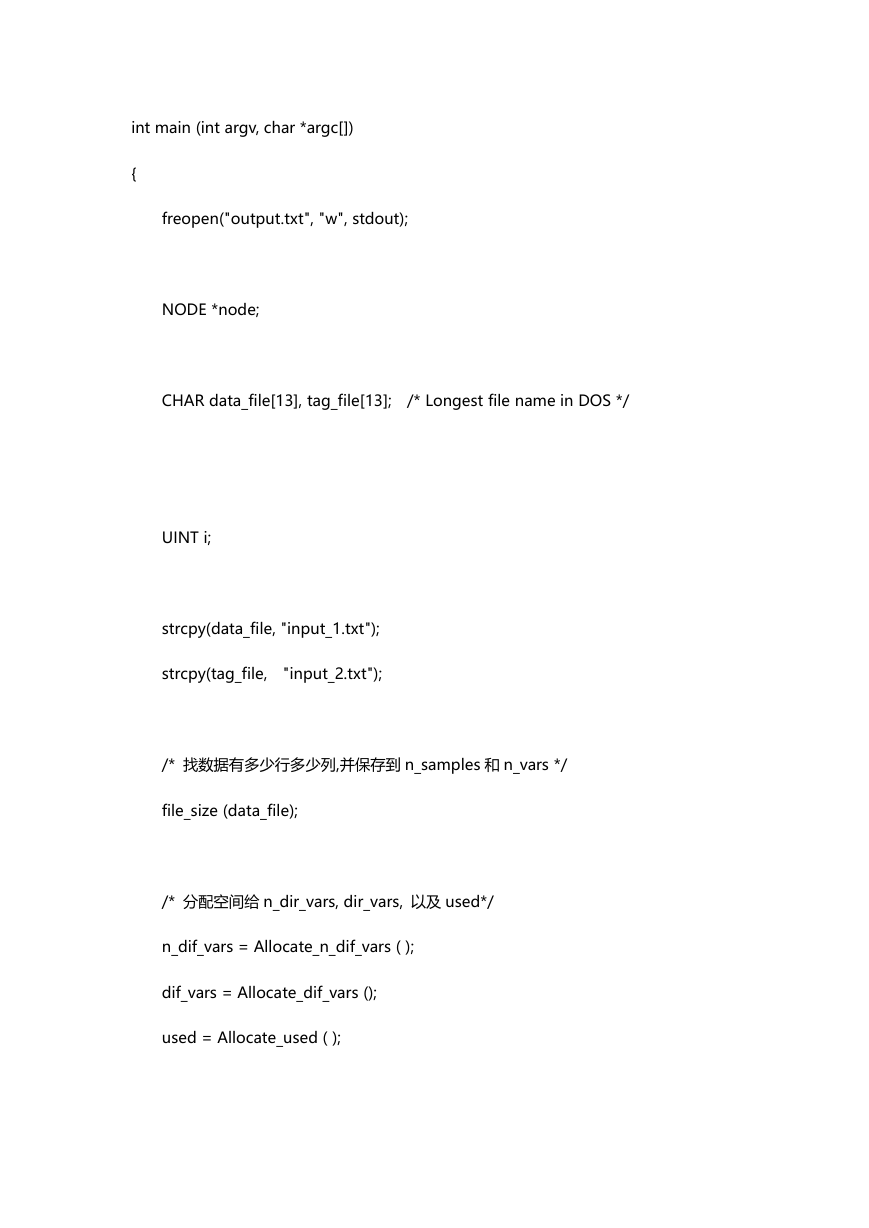实习一
分类技术及其应用
实习题 1 基于决策树的分类算法,属性的选择采用 ID3 或 C4.5 策略,采用如下的数据
建立分类决策树。
一、 算法基本思想的描述
1)
ID3 算法通过对一个训练例集进行学习生成一棵决策树,训练例集中的每一个例子都组
织成属性—属性值对的形式。假设一个例子仅属于正例(符合被学习目标概念的例子) 或
反例(不符合目标概念的例子) 两种分类之一,例子的所有属性都为离散属性。对于每个
训练例集 Es ,如果正例的比例为 p, 则反例比例就为 q = 1 - p , 熵的公式为:Entropy
( Es ) = p * log(1 / p) + (1 - p) * log(1 / (1 - p))
2) 若 用 属 性 A 将 训 练 例 集 Es 分 组 , Entropy( Es ) 将 会 降 低 , 新 的 期 望 信 息 量 设
为:New_Entropy ( Esi , A) =Σi ∈Value ( A)(| Esi | / | Es | ) Entropy (Esi )
�
3) A 相对于 Es 的信息赢取 Gain ( Es , A ) , 即 Ent ropy ( Es ) 降低的数量,信息赢取越大
的属性对训练例集越有利:Gain( Es ,A) = Entropy( Es ) - New_Entropy( Esi , A)
二、 编程实现算法
/***********************************id3.h***********************************/
typedef unsigned int UINT;
typedef unsigned long ULONG;
typedef
char CHAR;
typedef unsigned char BOOL;
typedef double
REAL;
typedef
char STRING[20];
typedef struct node {
UINT tag_idx; /* ID code for attribute */
UINT dif_var_idx;
struct node *parent; /* Addess of parent node */
struct node **child; /* Address of 'on' node */
} NODE;
typedef struct ne_struct {
REAL ne;
UINT status;
�
} NEGENTROPY;
typedef struct matrix {
UINT width;
UINT height;
STRING **data;
} MATRIX;
enum {
INACTIVE = 0,
ACTIVE
= 1,
INVALID_TAG_IDX = 0XFFFF,
INVALID_DIF_VAR_IDX = 0XFFFF
};
#define LN_2 0.693147180559945309417
#define entropy(x) (x > 0 ? x * log(x) / LN_2 : 0.0)
/***********************************proto.h***********************************/
NEGENTROPY negentropy ( UINT column, NODE *parent );
void print_tree ( NODE *node, UINT level);
void free_tree ( NODE * );
NODE* ID3 ( NODE* parent, UINT state, UINT *used );
�
void err_exit ( CHAR* , UINT );
MATRIX *build_matrix ( );
void free_matrix ( );
void read_matrix ( CHAR * );
void file_size ( CHAR * );
CHAR **read_tags ( CHAR * );
void free_tags ();
UINT *Allocate_n_dif_vars ( );
UINT *Allocate_used ();
STRING **Allocate_dif_vars ();
void find_dif_vars (CHAR *file_name);
bool exsit(UINT n_dif_vars, UINT i, CHAR *ptr);
/***********************************id3.cpp***********************************/
#include
#include
#include
#include
#include
#include
#include
#include
�
#include "id3.h"
#include "proto.h"
/*-------------------------------------------------------------------*/
MATRIX *matrix;
/* 读进整个数据 */
CHAR **tag_names;
/* 读进属性名 */
UINT target,
/* 决策是在哪一列,即 type 是在哪一列 */
n_vars,
/* 数据有几列 */
n_samples;
/* 数据有几行 */
UINT *n_dif_vars;
/* 各列有几个不同的值 */
STRING **dif_vars; /* 各列不同的值 */
UINT MAX_N_DIF_VARS = 10; /* 假设每列最大的不同值个数为 10 */
UINT *used;
/* 在建树时用来判断哪些列被搜索过了 */
�
int main (int argv, char *argc[])
{
freopen("output.txt", "w", stdout);
NODE *node;
CHAR data_file[13], tag_file[13];
/* Longest file name in DOS */
UINT i;
strcpy(data_file, "input_1.txt");
strcpy(tag_file,
"input_2.txt");
/* 找数据有多少行多少列,并保存到 n_samples 和 n_vars */
file_size (data_file);
/* 分配空间给 n_dir_vars, dir_vars, 以及 used*/
n_dif_vars = Allocate_n_dif_vars ( );
dif_vars = Allocate_dif_vars ();
used = Allocate_used ( );
�
/* 找各列不同的值,并记录到 dif_vars[][]里 */
find_dif_vars (data_file);
/* 读进属性名 */
tag_names = read_tags (tag_file);
/* 分配空间给 matrix */
matrix = build_matrix ();
/* 读进整个数据 */
read_matrix (data_file);
/* 分类目标是最后一列 */
target = n_vars - 1;
/* 初始化各列都还没有搜索过 */
for (i=0; i
/* 输出决策树 */
print_tree(node, 0);
/* 释放空间 */
free_tags ( );
free_matrix ( );
free_tree (node);
return 0;
}
/*-------------------------------------------------------------------*/
void print_type ( NODE *node )
{
STRING **data;
NODE *_local;
UINT i;
BOOL _match;
data = matrix->data;
�
















 2023年江西萍乡中考道德与法治真题及答案.doc
2023年江西萍乡中考道德与法治真题及答案.doc 2012年重庆南川中考生物真题及答案.doc
2012年重庆南川中考生物真题及答案.doc 2013年江西师范大学地理学综合及文艺理论基础考研真题.doc
2013年江西师范大学地理学综合及文艺理论基础考研真题.doc 2020年四川甘孜小升初语文真题及答案I卷.doc
2020年四川甘孜小升初语文真题及答案I卷.doc 2020年注册岩土工程师专业基础考试真题及答案.doc
2020年注册岩土工程师专业基础考试真题及答案.doc 2023-2024学年福建省厦门市九年级上学期数学月考试题及答案.doc
2023-2024学年福建省厦门市九年级上学期数学月考试题及答案.doc 2021-2022学年辽宁省沈阳市大东区九年级上学期语文期末试题及答案.doc
2021-2022学年辽宁省沈阳市大东区九年级上学期语文期末试题及答案.doc 2022-2023学年北京东城区初三第一学期物理期末试卷及答案.doc
2022-2023学年北京东城区初三第一学期物理期末试卷及答案.doc 2018上半年江西教师资格初中地理学科知识与教学能力真题及答案.doc
2018上半年江西教师资格初中地理学科知识与教学能力真题及答案.doc 2012年河北国家公务员申论考试真题及答案-省级.doc
2012年河北国家公务员申论考试真题及答案-省级.doc 2020-2021学年江苏省扬州市江都区邵樊片九年级上学期数学第一次质量检测试题及答案.doc
2020-2021学年江苏省扬州市江都区邵樊片九年级上学期数学第一次质量检测试题及答案.doc 2022下半年黑龙江教师资格证中学综合素质真题及答案.doc
2022下半年黑龙江教师资格证中学综合素质真题及答案.doc